World Roundup
July/August 2015


-
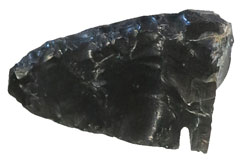 CANADA: The archaeological record from most of human history is largely represented by stone tools and points (with some bone and shell), so archaeologists must devise clever ways of extracting information from these artifacts. Recent work has shown that microscopic ripple marks in stone can be used to infer how fast a projectile point was initially propelled. The technique has been applied to several hundred ancient North American points, and revealed the first empirical evidence for the use of spear-throwers, or atlatls, which can drive darts faster than javelin-like throws. —Samir S. Patel
CANADA: The archaeological record from most of human history is largely represented by stone tools and points (with some bone and shell), so archaeologists must devise clever ways of extracting information from these artifacts. Recent work has shown that microscopic ripple marks in stone can be used to infer how fast a projectile point was initially propelled. The technique has been applied to several hundred ancient North American points, and revealed the first empirical evidence for the use of spear-throwers, or atlatls, which can drive darts faster than javelin-like throws. —Samir S. Patel -
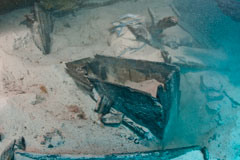 BERMUDA: The last 150 years have not been kind to five sealed bottles of wine that had been hidden in the bow of Mary Celestia, a Civil War blockade-runner that sank after hitting a reef in 1864 . At a food festival in Charleston, South Carolina, wine experts opened one of the bottles—which were excavated from the site in 2011—to find a gray liquid redolent of crab water, gasoline, saltwater, and vinegar, with hints of citrus and alcohol. —Samir S. Patel
BERMUDA: The last 150 years have not been kind to five sealed bottles of wine that had been hidden in the bow of Mary Celestia, a Civil War blockade-runner that sank after hitting a reef in 1864 . At a food festival in Charleston, South Carolina, wine experts opened one of the bottles—which were excavated from the site in 2011—to find a gray liquid redolent of crab water, gasoline, saltwater, and vinegar, with hints of citrus and alcohol. —Samir S. Patel -
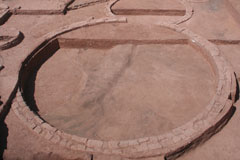 BOLIVIA: At a pre-Tiwanaku ceremonial center near Lake Titicaca called Khonkho Wankane, archaeologists have found evidence of a “defleshing” ritual. In an unlooted ceremonial room were hundreds of bits of human bone coated in white plaster, as well as blocks of calcium oxide, or quicklime, which becomes a caustic solvent when mixed with water and heated. The researchers surmise that pilgrims brought remains of their loved ones to this site to have flesh removed so they could keep the large, preserved bones as relics. —Samir S. Patel
BOLIVIA: At a pre-Tiwanaku ceremonial center near Lake Titicaca called Khonkho Wankane, archaeologists have found evidence of a “defleshing” ritual. In an unlooted ceremonial room were hundreds of bits of human bone coated in white plaster, as well as blocks of calcium oxide, or quicklime, which becomes a caustic solvent when mixed with water and heated. The researchers surmise that pilgrims brought remains of their loved ones to this site to have flesh removed so they could keep the large, preserved bones as relics. —Samir S. Patel -
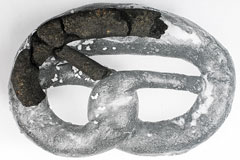 GERMANY: The future site of a Bavarian history museum has yielded a few bites of its past, including the world’s oldest known pretzels. The site was home to a bakery for many years prior to the mid-19th century, and among the finds were three small cakes, a fragment of a kipferl (a crescent-shaped local specialty), and pieces of two pretzels. The foods were preserved because they had been burnt, leading the archaeologists to joke that they may have been discarded by a frustrated baker. —Samir S. Patel
GERMANY: The future site of a Bavarian history museum has yielded a few bites of its past, including the world’s oldest known pretzels. The site was home to a bakery for many years prior to the mid-19th century, and among the finds were three small cakes, a fragment of a kipferl (a crescent-shaped local specialty), and pieces of two pretzels. The foods were preserved because they had been burnt, leading the archaeologists to joke that they may have been discarded by a frustrated baker. —Samir S. Patel -
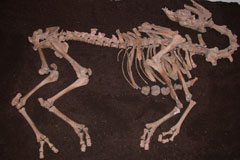 AUSTRIA: In 1683, Ottoman troops laid siege to—but did not conquer—the town of Tulln. Excavations in 2006 found traces of their presence: the bones of a camel. Archaeologists and veterinarians have studied the remains and found that the animal was no beast of burden, but rather a slender riding camel. It was also a mix of a dromedary and a Bactrian camel, which may have given it “hybrid vigor.” It’s not clear how the animal came to be in the town, but it may have been involved in an exchange across the siege line. —Samir S. Patel
AUSTRIA: In 1683, Ottoman troops laid siege to—but did not conquer—the town of Tulln. Excavations in 2006 found traces of their presence: the bones of a camel. Archaeologists and veterinarians have studied the remains and found that the animal was no beast of burden, but rather a slender riding camel. It was also a mix of a dromedary and a Bactrian camel, which may have given it “hybrid vigor.” It’s not clear how the animal came to be in the town, but it may have been involved in an exchange across the siege line. —Samir S. Patel -
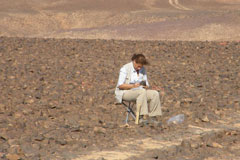 LIBYA: The plateau atop a sandstone outcrop called Messak Settafet in the central Sahara could be the earliest example of an entire landscape created and modified by humans. Archaeologists found an average of 75 lithics per square meter—a carpet of stone tools and man-made fragments spanning hundreds of thousands of years and perhaps thousands of square miles. The finds demonstrate just how important tool technologies were for early hominins, and that the area was likely a magnet for stone-hungry populations across the region. —Samir S. Patel
LIBYA: The plateau atop a sandstone outcrop called Messak Settafet in the central Sahara could be the earliest example of an entire landscape created and modified by humans. Archaeologists found an average of 75 lithics per square meter—a carpet of stone tools and man-made fragments spanning hundreds of thousands of years and perhaps thousands of square miles. The finds demonstrate just how important tool technologies were for early hominins, and that the area was likely a magnet for stone-hungry populations across the region. —Samir S. Patel -
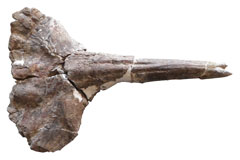 KENYA: Millions of years ago, the East African landscape shifted from forest to savanna. Caused by a tectonic uplift of the East African Plateau, this change is thought to have encouraged primates to descend from the trees and begin walking upright, but it is not known exactly when it occurred. The fossilized jawbone of a whale that swam up an ancient river before dying has helped scientists determine that the uplift started at least 17 million years ago. The jawbone, originally discovered in 1964, had been lost until it turned up in 2011 in the Harvard office of late paleontologist Stephen Jay Gould. —Samir S. Patel
KENYA: Millions of years ago, the East African landscape shifted from forest to savanna. Caused by a tectonic uplift of the East African Plateau, this change is thought to have encouraged primates to descend from the trees and begin walking upright, but it is not known exactly when it occurred. The fossilized jawbone of a whale that swam up an ancient river before dying has helped scientists determine that the uplift started at least 17 million years ago. The jawbone, originally discovered in 1964, had been lost until it turned up in 2011 in the Harvard office of late paleontologist Stephen Jay Gould. —Samir S. Patel -
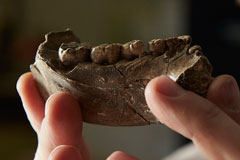 ETHIOPIA: A recently discovered fossilized mandible may represent the earliest member of the genus Homo: It dates to around 2.8 million years ago, or 500,000 years earlier than the next oldest known examples. This period in human evolution—the transition from Australopithecus to Homo—is still not well understood ("The First Toolkit," page 12). The bone and teeth have traits that appear to bridge the earlier (rounded chin) and later (slimmer molars) species. It may be a key finding for understanding the origins of our genus. —Samir S. Patel
ETHIOPIA: A recently discovered fossilized mandible may represent the earliest member of the genus Homo: It dates to around 2.8 million years ago, or 500,000 years earlier than the next oldest known examples. This period in human evolution—the transition from Australopithecus to Homo—is still not well understood ("The First Toolkit," page 12). The bone and teeth have traits that appear to bridge the earlier (rounded chin) and later (slimmer molars) species. It may be a key finding for understanding the origins of our genus. —Samir S. Patel -
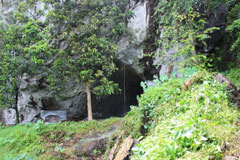 SRI LANKA: It was thought that humans didn’t begin to live in tropical rain forests and rely on their resources until about 8,000 years ago, in part because the environment can be difficult to navigate and contains fewer accessible food sources than savanna or grasslands. But a new study of isotopic data from human remains dating back 20,000 years shows that until the dawn of agriculture on the island, people actually relied almost exclusively on food from rain forest–related environments rather than open grassland. —Samir S. Patel
SRI LANKA: It was thought that humans didn’t begin to live in tropical rain forests and rely on their resources until about 8,000 years ago, in part because the environment can be difficult to navigate and contains fewer accessible food sources than savanna or grasslands. But a new study of isotopic data from human remains dating back 20,000 years shows that until the dawn of agriculture on the island, people actually relied almost exclusively on food from rain forest–related environments rather than open grassland. —Samir S. Patel -
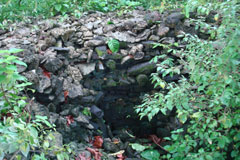 MICRONESIA: Nan Madol, the ruined ancient canal-city, has a lesser known sister site in Leluh off the island of Kosrae. Like Nan Madol, Leluh contains walls and canals of basalt, but it also has tombs partially built with live coral. Scientists dated coral from the tombs to as early as the 1300s, 300 years older than they had been thought to be. Early establishment of the city suggests a long history as a significant political and economic force in the region and rival to Nan Madol. —Samir S. Patel
MICRONESIA: Nan Madol, the ruined ancient canal-city, has a lesser known sister site in Leluh off the island of Kosrae. Like Nan Madol, Leluh contains walls and canals of basalt, but it also has tombs partially built with live coral. Scientists dated coral from the tombs to as early as the 1300s, 300 years older than they had been thought to be. Early establishment of the city suggests a long history as a significant political and economic force in the region and rival to Nan Madol. —Samir S. Patel
Advertisement
IN THIS ISSUE
From the Trenches
A Spin through Augustan Rome
Off The Grid
The First Toolkit
Anglo-Saxon Jewelry Box
Wrecks of the Pacific Theater
The Environmental Cost of Empire
One Ring to Bind Them
Cosmic Rays and Australopithecines
Bison Bone Mystery
Rome's Earliest Fort
A Parisian Plague
Finding Lost African Homelands
Neanderthal Necklace
Slime Molds and Roman Roads
Open House
World Roundup
Civil War booze, world’s oldest pretzels, Austria’s war camels, coral tombs of the Pacific, and a 2.8-million-year-old human
Artifact
Styling hair in Bronze Age Wales
Advertisement

Recent Issues
-
 May/June 2024
May/June 2024
-
 March/April 2024
March/April 2024
-
 January/February 2024
January/February 2024
-
 November/December 2023
November/December 2023
-
 September/October 2023
September/October 2023
-
 July/August 2023
July/August 2023
-
 May/June 2023
May/June 2023
-
 March/April 2023
March/April 2023
-
 January/February 2023
January/February 2023
-
 November/December 2022
November/December 2022
-
 September/October 2022
September/October 2022
-
 July/August 2022
July/August 2022
-
 May/June 2022
May/June 2022
-
 March/April 2022
March/April 2022
-
 January/February 2022
January/February 2022
-
 November/December 2021
November/December 2021
-
 September/October 2021
September/October 2021
-
 July/August 2021
July/August 2021
-
 May/June 2021
May/June 2021
-
 March/April 2021
March/April 2021
-
 January/February 2021
January/February 2021
-
 November/December 2020
November/December 2020
-
 September/October 2020
September/October 2020
-
 July/August 2020
July/August 2020
-
 May/June 2020
May/June 2020
-
 March/April 2020
March/April 2020
-
 January/February 2020
January/February 2020
-
 November/December 2019
November/December 2019
-
 September/October 2019
September/October 2019
-
 July/August 2019
July/August 2019
-
 May/June 2019
May/June 2019
-
 March/April 2019
March/April 2019
-
 January/February 2019
January/February 2019
-
 November/December 2018
November/December 2018
-
 September/October 2018
September/October 2018
-
 July/August 2018
July/August 2018
-
 May/June 2018
May/June 2018
-
 March/April 2018
March/April 2018
-
 January/February 2018
January/February 2018
-
 November/December 2017
November/December 2017
-
 September/October 2017
September/October 2017
-
 July/August 2017
July/August 2017
-
 May/June 2017
May/June 2017
-
 March/April 2017
March/April 2017
-
 January/February 2017
January/February 2017
-
 November/December 2016
November/December 2016
-
 September/October 2016
September/October 2016
-
 July/August 2016
July/August 2016
-
 May/June 2016
May/June 2016
-
 March/April 2016
March/April 2016
-
 January/February 2016
January/February 2016
-
 November/December 2015
November/December 2015
-
 September/October 2015
September/October 2015
-
 July/August 2015
July/August 2015
-
 May/June 2015
May/June 2015
-
 March/April 2015
March/April 2015
-
 January/February 2015
January/February 2015
-
 November/December 2014
November/December 2014
-
 September/October 2014
September/October 2014
-
 July/August 2014
July/August 2014
-
 May/June 2014
May/June 2014
-
 March/April 2014
March/April 2014
-
 January/February 2014
January/February 2014
-
 November/December 2013
November/December 2013
-
 September/October 2013
September/October 2013
-
 July/August 2013
July/August 2013
-
 May/June 2013
May/June 2013
-
 March/April 2013
March/April 2013
-
 January/February 2013
January/February 2013
-
 November/December 2012
November/December 2012
-
 Sep/Oct 2012
Sep/Oct 2012
-
 September/October 2012
September/October 2012
-
 July/August 2012
July/August 2012
-
 May/June 2012
May/June 2012
-
 March/April 2012
March/April 2012
-
 January/February 2012
January/February 2012
-
 November/December 2011
November/December 2011
-
 September/October 2011
September/October 2011
-
 July/August 2011
July/August 2011
-
 May/June 2011
May/June 2011
-
 March/April 2011
March/April 2011
-
 January/February 2011
January/February 2011
Advertisement






